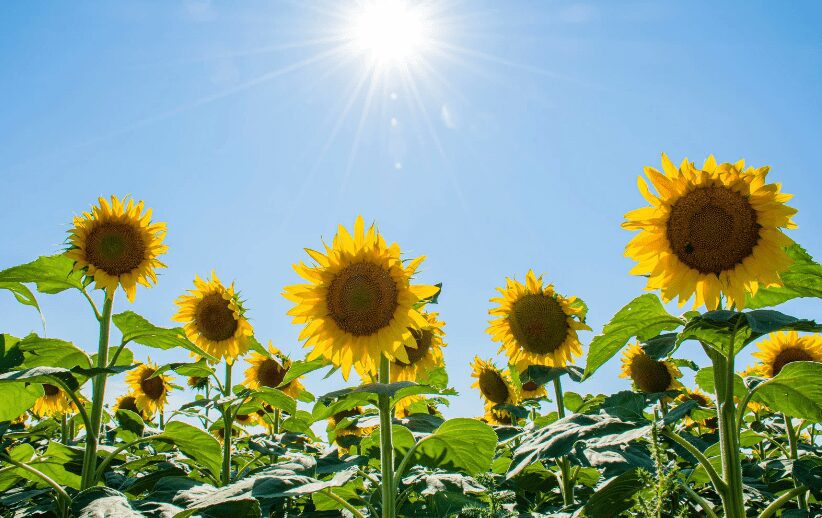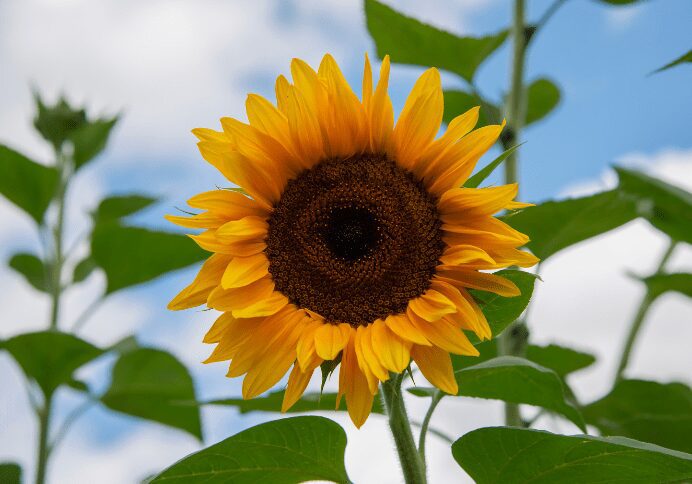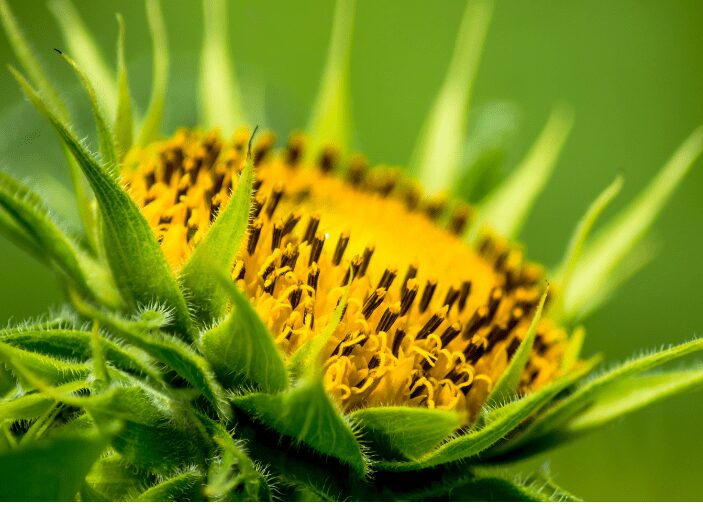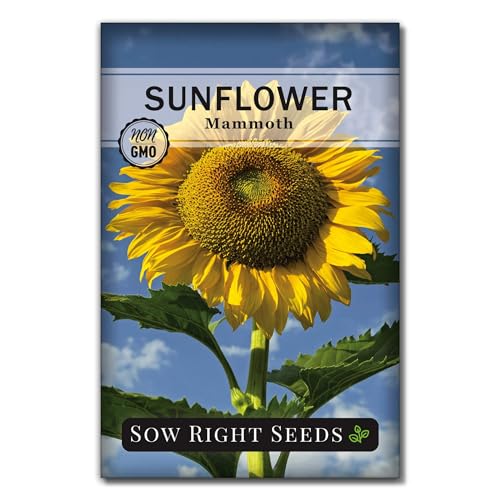
Sunflowers are tall, bright, and cheerful flowers that can add a splash of sunshine to any garden or landscape. Their striking yellow petals and dark centers have become a popular choice for gardeners and florists alike.
Please continue reading to find the different types of sunflowers, how to grow them, care for them, and explore the history and symbolism of these beautiful flowers.
Definition of Sunflowers Sunflowers
Also known as Helianthus annuus, annual plants belong to the Asteraceae family. They are native to North and Central America and were cultivated by Native Americans for their medicinal and culinary properties.
Importance of Sunflowers
Apart from their ornamental value, sunflowers have a range of uses. They are an important source of oil, which is used in cooking and as a biofuel. They are also used as birdseed and livestock feed. Sunflowers are also known for attracting bees and absorbing heavy metals and toxins from the soil, making them useful for phytoremediation.
Types of Sunflowers
Sunflowers come in various sizes and colors, with different types suited to other growing conditions.
Common Sunflowers

Common sunflowers, Helianthus annuus, are the most recognizable and widely cultivated variety. These classic flowers are known for their bright yellow petals and distinctive dark centers, which comprise thousands of tiny individual flowers.
Common sunflowers can grow quite tall, often reaching 6-10 feet, and produce large flower heads measuring up to a foot in diameter. They are a popular choice for home gardeners, as they are relatively easy to grow and care for.
In addition to their ornamental value, common sunflowers are also valued for their edible seeds, a popular snack food and ingredient in many recipes.
Whether grown for their beauty, nutritional value, or simply for the joy of gardening, common sunflowers are a beloved and iconic part of the natural world.
Giant Sunflower

Giant sunflowers are a breathtaking variety of the sunflower family, known for their impressive size and towering height. These magnificent plants can reach up to 16 feet tall and produce massive flower heads measuring over a foot in diameter.
With their striking yellow petals and dark centers, giant sunflowers are a true marvel of nature. In addition to their visual appeal, they are also a popular choice for gardeners looking to attract pollinators, as they produce abundant nectar and pollen.
Whether grown for their beauty, ecological benefits, or simply for fun, giant sunflowers are remarkable plants that never capture the imagination.
Dwarf Sunflower

Dwarf sunflowers are smaller and more compact, reaching a height of 2-4 feet. They are ideal for small gardens and containers and come in various colors like red, orange, and burgundy.
Dwarf sunflowers are a popular and charming variety of the sunflower family. As the name suggests, they are smaller than other sunflowers, with shorter stems and smaller flower heads. Despite their diminutive stature, they are no less impressive than their larger counterparts.
Many gardeners prefer dwarf sunflowers because they are easier to manage and care for. They are also an excellent option for container gardening or adding color and texture to small outdoor spaces.
With their bright and cheerful blooms, dwarf sunflowers will surely bring a smile to anyone’s face. Whether planted in a garden bed or a pot on a sunny windowsill, these delightful flowers are an excellent addition to any home or garden.
Growing Sunflowers
Growing sunflowers is relatively easy and requires minimal maintenance.
Here are some tips to get started:
Soil Preparation
Sunflowers prefer well-draining soil that is rich in organic matter. Prepare the ground by adding compost or well-rotted manure to improve its texture and fertility.
Planting
Sunflowers are usually planted directly in the soil by sowing or transplanting seedlings. Depending on the available space, they can be grown in rows or clusters. Plant the seeds about 1 inch deep and 6 inches apart.
Watering
Sunflowers need regular watering, especially during the hot summer months. Water deeply once or twice a week, ensuring the soil is moist but not waterlogged.
Fertilizing
Sunflowers benefit from regular fertilization, especially during their growing season. Apply a balanced fertilizer every 3-4 weeks to give them the nutrients for healthy growth.
Maintenance
Sunflowers require minimal maintenance, but it is essential to keep them weed-free to prevent competition for nutrients and water. Pinch off any dead or damaged leaves and flowers to encourage new growth.
Sunflower Care
While sunflowers are easy to grow, they have specific care requirements.
Sunlight Requirement
Sunflowers require full sun to thrive. Ensure they are planted in an area that receives at least 6-8 hours of direct sunlight daily.
Temperature
Sunflowers are heat-loving plants and can tolerate high temperatures, but they do not like frost. Plant them after the last frost in your area and protect them from cold snaps with a cover or blanket.
Pest and Disease Control
Sunflowers are relatively resistant to pests and diseases but can be affected by aphids, slugs, and fungal infections. Monitor your plants regularly and treat any infestations promptly with natural or chemical controls.
Harvesting
Sunflowers are usually harvested for their seeds, which can be roasted, eaten, or used to make oil.
How to harvest sunflower seeds
Harvesting sunflower seeds is a relatively simple process. Here are the steps you can follow:
-
Check if the sunflower seeds are ready for harvest:
The sunflower heads will droop down, and the back of the flower head will turn yellow or brown. The petals will also start to fall off.
2. Cut the flower head:
Use sharp scissors or a knife to cut the flower head off the stalk. Leave about 4 inches of stem attached to the flower head.
3. Dry the flower head:
Hang the flower head upside down in a dry, well-ventilated area. You can also place it on a screen or tray in a warm, dry location. The flower head will take about 2-3 weeks to dry.
4. Remove the seeds:
Once the flower head is dry, rub your hand over the flower head to dislodge the seeds. Alternatively, you can use a fork or a stiff brush to remove the seeds. Be gentle to avoid damaging the seeds.
5. Clean the seeds:
Remove any remaining debris, petals, or chaff from the seeds. You can do this by placing the seeds in a bowl and gently blowing on them or using a fine-mesh sieve.
6. Store the seeds:
Place the clean seeds in an airtight container and store them in a cool, dry location. Sunflower seeds can be stored for up to a year.
That’s it! Follow these steps, and you’ll have a bounty of sunflower seeds to enjoy.
About Sunflowers
Sunflowers have a rich history and symbolism that goes beyond their physical beauty.
History of Sunflowers
Sunflowers have been cultivated for thousands of years, with evidence of their cultivation dating back to ancient American civilizations. They were brought to Europe in the 16th century and have become a popular garden and agricultural crop worldwide.
Sunflower Symbolism
Sunflowers are often associated with happiness, loyalty, and longevity. They also symbolize the sun, representing warmth, light, and energy. In some cultures, sunflowers are associated with harvest time and the earth’s bounty.
Heliopsis Vs. Helianthus
Heliopsis and Helianthus are two different genera of flowering plants that belong to the same family Asteraceae. They are commonly known as False sunflowers and True sunflowers, respectively.
Here are some critical differences between Heliopsis and Helianthus:
1. Appearance:
Heliopsis and Helianthus have different physical characteristics. Heliopsis plants have daisy-like flowers with yellow petals and a dark brown center. They grow to 2-5 feet tall and have lance-shaped leaves.
Conversely, Helianthus has larger flower heads with bright yellow petals and a brown or black center. They can grow up to 10 feet tall and have large, broad leaves.
2. Origin:
Heliopsis is native to North America, while Helianthus is native to North and South America.
3. Growing conditions:
Heliopsis and Helianthus are hardy plants that can tolerate various growing conditions. However, Heliopsis prefers moist, well-drained soil and partial shade, while Helianthus thrives in full sun and well-drained soil.
4. Uses:
Heliopsis and Helianthus are popular garden plants attracting bees, butterflies, and other pollinators. Heliopsis is often used in borders, rock gardens, and wildflower gardens, while Helianthus is commonly grown for its edible seeds and oil.
In summary, Heliopsis and Helianthus are two different flowering plant genera with distinct physical characteristics, origins, growing conditions, and uses.
FAQs
1. How long do sunflowers take to grow?
Depending on the variety, sunflowers typically take around 80-100 days to mature.
2. What are the benefits of growing sunflowers?
Apart from their ornamental value, sunflowers can be used for food, fuel, and phytoremediation.
3. Can sunflowers grow in pots?
Yes, dwarf sunflowers can be grown in pots or containers.
4. How often do sunflowers need to be watered?
Sunflowers should be watered deeply once or twice a week, depending on the weather conditions.
5. What are some common pests and diseases that affect sunflowers?
Aphids, slugs, and fungal infections are the most common pests and diseases that affect sunflowers.
6. Can sunflowers grow in any soil?
Sunflowers prefer well-draining soil that is rich in organic matter. However, they can tolerate a wide range of soil types as long as they are not waterlogged.
7. When should sunflowers be planted?
Sunflowers should be planted after the last frost in your area, usually in late spring or early summer.
8. How tall can sunflowers grow?
Sunflowers can grow up to 16 feet tall for the big variety, but dwarf sunflowers only reach 2-4 feet.
9. Can sunflowers be used for oil production?
Yes, sunflowers are a significant source of vegetable oil and can be used for cooking or as a biofuel.
10. How can I keep sunflowers from drooping?
Sunflowers can become top-heavy and droop under the weight of their large flowers. You can support them with stakes or trellises to prevent them from bending over.
Conclusion
Sunflowers are a beloved and iconic plant that benefits gardeners and nature enthusiasts. Whether you prefer dwarf varieties or giant sunflowers that reach heights of 16 feet, there are wide sunflower varieties to choose from that suit your needs and preferences.
Sunflowers grow well in full sun and well-draining soil and benefit from regular watering and fertilizing. They are also known for their edible seeds, a popular snack food and ingredient in many recipes. While sunflowers are relatively easy to grow, they are susceptible to various pests and diseases, so care must be taken to protect them from harm.
However, sunflowers can thrive season-long and produce multiple blooms with good air circulation, adequate spacing, and slow-release granular fertilizer. Whether you use them as ornamental plants, for cut flowers, or as a food source, sunflowers are a delight to grow and share with others.
So plant some seeds and watch them germinate into beautiful sunflowers that catch the eyes of birds, insects, and humans alike!
Growing sunflowers can be a fun and rewarding experience for gardeners of all levels. Following the tips in this article, you can successfully grow and care for sunflowers in your garden or landscape.
Remember to choose the suitable variety for your growing conditions, provide adequate sunlight, water, and nutrients, and keep them from pests and diseases.
Whether looking for a splash of color in your garden or a source of food and fuel, sunflowers are versatile and beautiful plants that can brighten your life.
In addition to their ornamental and culinary uses, sunflowers play an essential ecological role. They are known for attracting beneficial insects such as bees, butterflies, and caterpillars, which help pollinate other garden plants and crops.
Sunflowers also provide food and habitat for birds and wildlife, making them an essential part of any backyard ecosystem. Additionally, many Native American tribes have long valued sunflowers for their symbolic and medicinal properties, using them to treat various ailments and as a source of yellow dye.
Sunflowers are relatively easy to plant, with direct seeding being the most straightforward method. However, starting them indoors can provide an earlier start and more prominent flowers. Choosing a good location for planting sunflowers is essential, with full sun and good drainage being critical factors for success.
Sunflowers also require adequate space, with more extensive varieties needing up to 2 feet between plants. Once planted, it’s important to water deeply and consistently, not letting the soil dry out completely.
Mulching can help to retain moisture and reduce weed growth, but care must be taken not to mulch too close to the stem to avoid fungal diseases.
Harvesting sunflower seeds is a fun and rewarding task that can provide a delicious snack or ingredient for cooking. To harvest sunflower seeds, wait until the flower head has dried and the back of the flower head turns brown.
Cut the flower head off the stem and hang it upside down in a warm, dry place to dry. Once the flower head has dried completely, gently rub the seed heads to catch loose seeds.
To remove the seeds from the seed head, rub them with your hands or use a fork to pry them loose. Save some seeds for planting next year and share the rest with friends or wildlife.
In conclusion, sunflowers are one of the easiest flowers to grow, offering much more than a pretty bloom. From their ecological benefits to their culinary uses, sunflowers have been inspiring and delighting people for generations.
So next time you see a field of sunflowers or a single flower head standing tall, take a moment to appreciate their beauty and all they offer.
Last update on 2024-07-26 / Affiliate links / Images from Amazon Product Advertising API


























